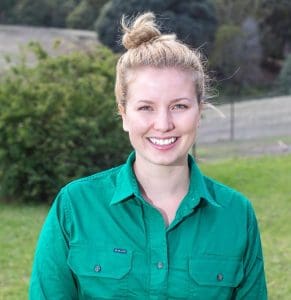
La Trobe University PhD student and footrot researcher Nickala Best.
IMPROVED on-farm footrot diagnostic tools could result from research and survey work underway by PhD candidate Nickala Best and her La Trobe University colleagues.
The La Trobe University research could also lead to the development of a new framework for field testing and diagnosis of other diseases.
Ms Best is currently distributing an online survey to investigate the attitudes of sheep producers toward current footrot diagnostic methods and how new methods might be best implemented to improve disease control.
“As a part of this project, I’m interested in conducting a survey of sheep owners about the current state of diagnostics for footrot.
“We’d like to know what they use, how happy they are with it, what they would ideally like to see, and how they think any new methods would be best implemented to improve the control of the disease,” she said.
Ms Best’s honours project involved assessing a laboratory test to distinguish the bacterial protease produced by virulent and benign footrot. It was tested on Victorian footrot samples.
“It has been done in Europe, but as far we know no-one had looked at Australian clinical samples.
“There is a very good correlation between the protease being present in the footrot bacteria Dichelobacter nodosus and a sheep having severe lesions.”
An honours project is continuing work using that laboratory test to investigate how the disease progresses through the year when healthy animals have the bacteria detected.
Ms Best would also like to know what diagnostic techniques producers would like to have available and how they perceive any new diagnostic tools would be best implemented for the improved footrot control. This information will be used to inform the larger research scope to better serve industry, she said.
In Australia, footrot is initially diagnosed by visual inspection and smelling of sheep hooves, by a producer, veterinarian or trained livestock contractor. However, Ms Best the research is focussing on detecting the causative bacteria and determining when producers would like to use any new diagnostic tool.
“And if we did have something new for them, where would they like to use it and how would they think it might help them.”
Ms Best said footrot is a useful model for the development of a framework for other on-farm disease testing and diagnosis.
She hoped to get some understanding of how producers diagnose and manage the disease from the survey. After six weeks, about 15 surveys have been completed.
“I’m aiming for 150 respondents, hopefully by December.”
No personal information will be collected in the survey, however a postcode is required. Surveys will be anonymous and the data will be stored on a password-protected computer and Excel spreadsheet. Data may also be included in a thesis, presented at a conference and/or published in a scientific journal article, presented in a summary format with no individual identifiers.
Researchers plan to publish the results of the footrot survey in mid-2017. Click here this link to complete the confidential footrot survey.

We breed Dorper Sheep now but have previously had cross bred sheep. We have never treated for foot rot and have never had it on our property (19 years). We are on very flat land so sometimes get foot abscesses when the ground is wet for long periods as it is at the moment.